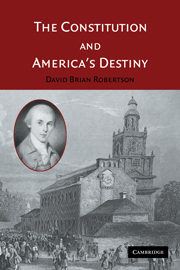Book contents
- Frontmatter
- Contents
- List of Tables and Figures
- Preface
- Acknowledgments
- List of Abbreviations
- 1 Politics and the Constitution
- 2 The Policy Crisis of the 1780s
- 3 James Madison's Plan for the Constitutional Convention
- 4 The Political Landscape of the Constitutional Convention
- 5 Who Governs? Constituting Policy Agency
- 6 What Can Be Governed? Constituting Policy Authority
- 7 How Is the Nation Governed? Constituting the Policy Process
- 8 Our Inheritance: The Constitution and American Politics
- Index
1 - Politics and the Constitution
Published online by Cambridge University Press: 11 November 2009
- Frontmatter
- Contents
- List of Tables and Figures
- Preface
- Acknowledgments
- List of Abbreviations
- 1 Politics and the Constitution
- 2 The Policy Crisis of the 1780s
- 3 James Madison's Plan for the Constitutional Convention
- 4 The Political Landscape of the Constitutional Convention
- 5 Who Governs? Constituting Policy Agency
- 6 What Can Be Governed? Constituting Policy Authority
- 7 How Is the Nation Governed? Constituting the Policy Process
- 8 Our Inheritance: The Constitution and American Politics
- Index
Summary
[T]here can be no doubt but that the result [of the Constitutional Convention] will in some way or other have a powerful effect on our destiny.
– James Madison to Thomas Jefferson, June 6, 1787What problems were the U.S. Constitution's authors trying to solve? How did they imagine their Constitution would answer these problems? We know the framers intended to change America's destiny, and we know they succeeded. But how did they intend to transform the way American government uses its power and the way Americans use their government? What kinds of politics were the delegates to the Constitutional Convention trying to make – and what kinds of politics did their design make? For all that has been written about the Constitution, we do not have satisfactory answers to these questions.
Practicing politicians wrote the Constitution, and they expected politicians to use it. To understand the enduring effects of the Constitution on America's destiny, we need to know what its designers thought they were doing. We need to understand the circumstances that convinced these politicians that they could and should reconstitute the nation's government. We need to understand precisely how these circumstances shaped their strategies for building a new government. We need to reconstruct how these politicians used such strategies to design their Constitution, provision by provision. Better answers to these questions can help us better understand how Americans have used the government they have inherited.
- Type
- Chapter
- Information
- The Constitution and America's Destiny , pp. 1 - 29Publisher: Cambridge University PressPrint publication year: 2005



